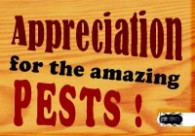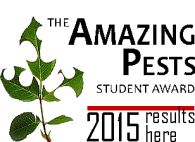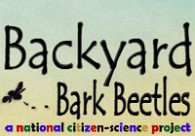Announcements
Student Award for the Appreciation for the Natural History of Insect Pests 2016
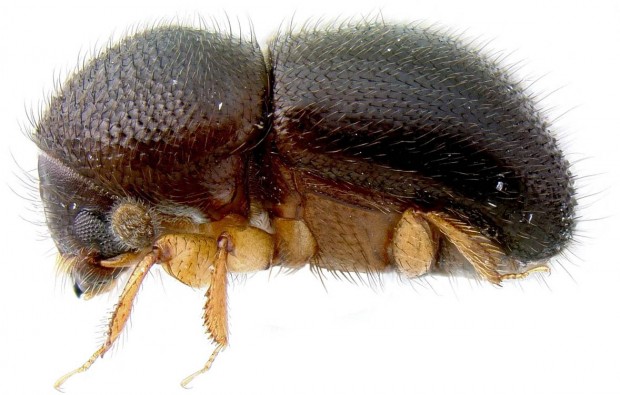
Like this bizarre Cyclorhipidion spurlinum, a newly discovered ambrosia beetle from Papua New Guinea, many insects belong to groups called “pests”, but the organisms themselves are a source of wonder to an observant entomologist.
Now in its fifth year: 2016
The purpose of the award
The award serves to promote the study of unexplored aspects of natural history of insect pests. Due to their success in the competition with humans, these insect groups are often condemned as harmful, while their remarkable qualities and peculiarities remain unnoticed. For example, only a handful of species of bark and ambrosia beetles cause damage to humans, while most of the remaining 7,500 species are fascinating organisms, cute and bizarre, living extraordinary lifestyles, and barely known to humans. The same discrepancy holds for many other insect groups. The main purpose of the award is to foster communication between fundamental and applied young entomologists, and increase their appreciation for each other’s study organisms and research methods.
The award
$500 awarded annually to a single recipient. The award is sponsored by the TREE Foundation in Sarasota, FL, and conferred by the Ambrosia Symbiosis Research Group (Jiri Hulcr and Andrea Lucky at University of Florida, Rob Dunn at North Carolina State University, and Anthony I. Cognato at Michigan State University).
Who is eligible
University students regardless of their geographic location (must be in student status at the time of submission of the competing manuscript)
Due date
Applications are due on December 31st, 2016.
Selection criteria and conditions
The selection committee will award $500 to the student who in the given year publishes the most interesting and inspiring research paper on insects which are usually regarded as pests. There are three conditions for consideration:
- the work may address any aspect of insect pest systematics, diversity, ecology, and other areas, but its main focus must not be consequences of such species to humans or pest management.
- the study must be at least “in print” in a scientific peer-reviewed journal by the annual deadline of the award,
- the applicant must be a student at the time of the application submission.
- the applicant must be the first author on the submitted paper.
Previous years
For the winners of the 2015 competition, click here.
For the winners of the 2014 competition, click here.
For the winners of the 2013 competition, click here.
How to apply
Please send a brief e-mail to hulcr@ufl.edu containing 1) a few words about yourself, 2) a contact information of a faculty member who can confirm your student status, 3) a one-sentence summary of your discovery, and 4) the competing publication as an attachment. There are no forms to fill out.
Please send any further inquiries to hulcr@ufl.edu.
Congratulations 2015 Winner!

Like this beautiful Paranthrene simulans, many insects pests are worth studying for more than how to kill them. A moth that looks like a hornet but is soft on touch, and whose caterpillar doesn’t eat plants but drills tunnels in living oak wood… is it a pest or is it a biological wonder? Photo © Mark Dreiling
Annual Student Award for the Appreciation for the Biology of Insect Pests
We are proud to announce the winner for the fourth year of the Award: 2015. A great number of papers was submitted, perhaps the highest quality so far. Submissions were received from students all around the world, all works of great passion for insects, full of intriguing discoveries. The committee has decided on the single winner. The prize of $500 will go to:
Andrea Lee Lawrence, University of Sydney, Australia
for her article “Evaluation of the bacterial microbiome of two flea species using different DNA-isolation techniques provides insights into flea host ecology” published in FEMS Microbiology: “Using a flea model, our paper shows that next-generation deep-sequencing can be used for detection of bacterial pathogens circulating at low levels in vector insects with simultaneous evaluation of microbial dynamics and flea biology, in this case revealing that host ecology drives low abundance bacterial diversity and that native echidna fleas host a significantly richer microbiome compared to the most common flea in the world, the cat flea.”
Congratulations, Andrea! Thank you all for your discoveries, and for your interest in the wonders of insect sometimes called pests. Our sincere thanks also go to all other students who submitted their papers. The complete list of submitted papers is below (see how great they were!).
This award serves to promote the study of unexplored aspects of natural history of insect pests. For more information on the award, and for submission of a paper for the year 2016 click here.
The award is supported by the TREE Foundation in Sarasota, FL, and conferred by the Ambrosia Symbiosis Research Group (Jiri Hulcr and Andrea Lucky at University of Florida, Rob Dunn at North Carolina State University, and Anthony I. Cognato at Michigan State University). Please send any further inquiries to hulcr@ufl.edu.
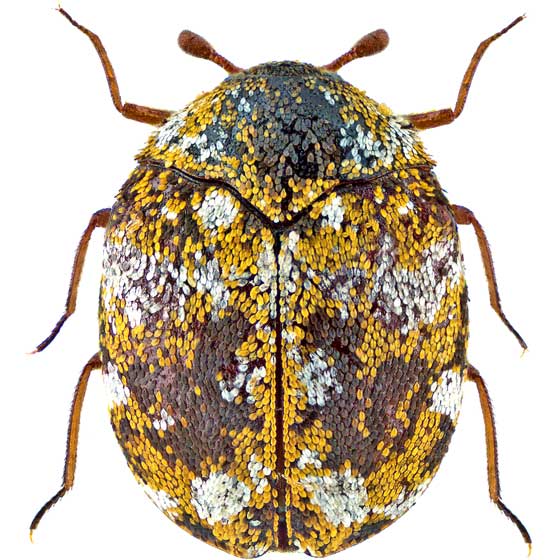
To most, this carpet beetle Anthrenus is just a domestic pest. But look closely, and you will see that it’s covered with specks of gold and silver. Why? No one knows… Photo Udo Schmidt, www.kaefer-der-welt.de
The complete list of papers submitted in 2015
- Jörg G. Stephan, Swedish University of Agricultural Sciences
How far away is the next basket of eggs? Spatial memory and perceived cues shape aggregation patterns in a leaf beetle. Ecology. The leaf beetle Phratora vulgatissima must employ some kind of spatial memory during oviposition because it is modulating the distances between egg clutches on a plant and it apparently also is more sensitive to the indirectly perceived number of conspecifics than the directly perceived number of conspecific eggs in evaluating the occupancy of a plant individual. - Duong T. Nguyen, Western Sydney University, Australia
Polyploidy versus endosymbionts in obligately thelytokous thrips. BMC Evolutionary Biology. I established genetic evidence for polyploidy as underlying mechanism for thelytokous reproduction in the invasive, economically important horticultural greenhouse pest Heliothrips haemorrhoidalis (and for thrips in general), while reproductive manipulators such as Wolbachia and Cardinium bacteria were excluded as contributing factors in the reproduction of this thrips species. - Yuen Han, Wageningen University, the Netherlands
Parasitic Manipulation of Host Behaviour: Baculovirus SeMNPV EGT Facilitates Tree-Top Disease in Spodoptera exigua Larvae by Extending the Time to Death. Insects. We investigated the mechanism by which the baculovirus SeMNPV induces tree-top disease (climbing to elevated positions prior to death) in caterpillar hosts and found that the viral egt gene facilitates baculovirus-induced tree-top disease by extending the larval time to death. Caterpillars infected with a mutant virus lacking the egt gene died before the onset of tree-top disease. - Ashley Mortensen, University of Florida
A scientific note on the prevalence of the cordovan phenotype in the African-derived honey bee population in the Southeastern United States. Apidologie. Discovery of recessive color mutant (cordovan), that was previously believed to only occur in European honey bees, in African honey bees. - Ashley Mortensen (2) , University of Florida
The frequency of African (Apis mellifera scutellata Lepeletier) matrilineal usurpation of managed European-derived honey bee (A. mellifera L.) colonies in the southeastern United States. Insectes Sociaux. A field study conducted to determine if African honey bee swarms actively take over (usurp) managed European honey bee colonies - Stephen Seaton, Murdoch University
Outbreak of Phoracantha semipunctata in Response to Severe Drought in a Mediterranean Eucalyptus Forest. Forests The first outbreak of the eucalyptus longicorn borer (Phoracantha semipunctata) in its native habitat followed a significant drought event, with borers attracted to severely stressed trees, and these trees provided an ideal environment for their development and emergence. - Guadalupe Andraca-Gomez, Universidad Nacional Autónoma de México
A potential invasion route of Cactoblastis cactorum within the Caribbean region matches historical hurricane trajectories. Biological Invasions. We found, through analysis of genetic variation, that natural phenomena such as hurricanes could promote the spread of invasive moth Cactoblastis cactorum in Caribbean and Atlantic American area. - Stav Talal, Tel-Aviv University, Israel
Discontinuous gas-exchange cycle characteristics are differentially affected by hydration state and energy metabolism in gregarious and solitary desert locusts. Journal of Experimental Biology. My finding suggests that desert locusts (Schistocerca gregaria) breathing pattern during rest depends on its hydration state and on metabolic fuel that it burns. - Mariom Carvajal, North Dakota State University
Revalidation of Ditomotarsus hyadesi Signoret, 1885 stat. rest. (Hemiptera: Heteroptera: Acanthosomatidae) with notes on its Natural History. Biodiversity and Natural History. We have discovered that the true bug that attacks berries in Patagonia is not Ditomotarsus punctiventris, but Ditomotarsus hyadesi; that it has an annual life cycle in which individuals change its body color according to the season and different females lay eggs of different colors, a trait that has been found in the family Acanthosomatidae for the first time. - Andrew Gherlenda, Western Sydney University
Climate change, nutrition and immunity: effects of elevated CO2 and temperature on the immune function of an insect herbivore. Journal of Insect Physiology. Our results showed that climate change, specifically elevated CO2, can simultaneously have positive (increased melanisation) and negative (reduced PO activity) effects on different aspects of the immune response of an insect herbivore which may alter the outcome of parasitoid or pathogen attack. - Aidan Hall, Western Sydney University
Anatomy of an outbreak: the biology and population dynamics of a Cardiaspina psyllid species in an endangered woodland ecosystem. Agricultural and Forest Entomology. I characterise abiotic and biotic factors in the outbreak dynamics of a native Cardiaspina lace lerp psyllid with a new Eucalyptus host tree association over thousands of hectares of critically endangered Australian woodlands. - Monica Young, University of Guelph
Patterns of Protein Evolution in Cytochrome c Oxidase 1 (COI) from the Class Arachnida. PLoS ONE. We found markedly different patterns of amino acid evolution in the class Arachnida in association with generation lengths of each lineage; orders with longer generation times tend to have slower rates of amino acid evolution, while orders with very short generation times tend to have substantially faster rates which were often accompanied by signs of dramatic protein change through the insertion or deletion of amino acids. - Carl Keiser, University of Pittsburgh
Individual differences in predators but not producers mediate the magnitude of a trophic cascade. Arthropod-Plant Interactions. Damage on plants by a community of insect herbivores was reduced only in the presence of an active predatory wolf spider via non-consumptive effects, but the presence of a sedentary spider was no better at reducing plant damage than communities that lacked a predator completely. - Diana Bezos, University of Valladolid, Spain
The pine shoot beetle Tomicus piniperda as a plausible vector of Fusarium circinatum in northern Spain. Annals of Forest Science. Tomicus piniperda is a likely vector of Fusarium circinatum in Pinus radiata plantations in northern Spain, on the basis of Leach’s postulates, as we found an important association between the shoot beetle and this pathogenic fungus - Warwick Allen, Louisiana State University
Multitrophic enemy escape of invasive Phragmites australis and its introduced herbivores in North America. Biological Invasions. Attack by monophagous Lipara spp. gall-flies was 3 times higher on native than invasive P. australis genotypes and 10 times higher in the invasive than native range, these patterns being driven by reduced predation and parasitism, respectively. - Santos Portugal, Mississippi State University
Attempts to feed larval Amblyomma americanum (L.) (Acari: Ixodidae) on three different arthropod hosts. Journal of Vector Ecology. Larval Lone star ticks (Amblyomma americanum) will imbibe hemolymph from non-hematophagous insects under laboratory conditions, which may have interesting implications concerning the evolution and ecology of endosymbionts and pathogens. - Alexis Beaurepaire, University of Halle, Germany
Host Specificity in the Honeybee Parasitic Mite, Varroa spp. in Apis mellifera and Apis cerana. Journal of Vector Ecology. Using Molecular tools, we investigated the transmission and hybridization potential of the Varroa mite between its new host, the Western honeybee (Apis mellifera) and its native Asian host (Apis cerana)
- 1
- 2


